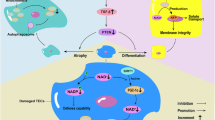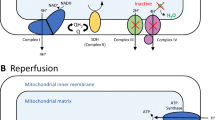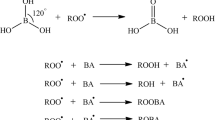We studied the development of acute kidney injury and animal death in the model of combined injury caused by kidney ischemia/reperfusion with simultaneous systemic administration of mitochondria. It was found that intraperitoneal injection of isolated mitochondria led to the appearance of mitochondrial DNA in the peripheral blood that could activate innate immunity. After administration of mitochondria, as well as after renal ischemia/reperfusion, proinflammatory changes were observed, primarily leukocytosis and granulocytosis. The combination of ischemia/reperfusion with injection of mitochondria caused a sharp increase in animal death, which may indicate a direct link between activation of TLR-signaling and high mortality of patients with combined injuries and multiple-organ failure in intensive care units. Treatment with mitochondria-targeted antioxidant increased animal survival, which indicated the participation of mitochondrial ROS in the development of systemic inflammatory response and death caused by acute renal failure.
Similar content being viewed by others
References
Bagshaw SM, George C, Dinu I, Bellomo R. A multi-centre evaluation of the RIFLE criteria for early acute kidney injury in critically ill patients. Nephrol. Dial. Transplant. 2008;23(4):1203-1210.
Clark A, Neyra J.A, Madni T, Imran J, Phelan H, Arnoldo B, Wolf SE. Acute kidney injury after burn. Burns. 2017;43(5):898-908.
Corradi F, Brusasco C, Vezzani A, Palermo S, Altomonte F, Moscatelli P, Pelosi P. Hemorrhagic shock in polytrauma patients: early detection with renal Doppler resistive index measurements. Radiology. 2011;260(1):112-118.
Han SJ, Li H, Kim M, Shlomchik MJ, Lee HT. Kidney proximal tubular TLR9 exacerbates ischemic acute kidney injury. J. Immunol. 2018;201(3):1073-1085.
He J, Lu Y, Xia H, Liang Y, Wang X, Bao W, Yun S, Ye Y, Zheng C, Liu Z, Shi S. Circulating mitochondrial DAMPs are not effective inducers of proteinuria and kidney injury in rodents. PLoS One. 2015;10(4):e0124469. https://doi.org/10.1371/journal.pone.0124469
Jastrow KM 3rd, Gonzalez EA, McGuire MF, Suliburk JW, Kozar RA, Iyengar S, Motschall DA, McKinley BA, Moore FA, Mercer DW. Early cytokine production risk stratifies trauma patients for multiple organ failure. J. Am. Coll. Surg. 2009;209(3):320-331.
Krug EG, Sharma GK, Lozano R. The global burden of injuries. Am. J. Public Health. 2000;90(4):523-526.
Likhvantsev VV, Landoni G, Grebenchikov OA, Skripkin YV, Zabelina TS, Zinovkina LA, Prikhodko AS, Lomivorotov VV, Zinovkin RA. Nuclear DNA as predictor of acute kidney injury in patients undergoing coronary artery bypass graft: a pilot study. J. Cardiothorac. Vasc. Anesth. 2017;31(6):2080-2085.
Prikhodko AS, Vitushkina MV, Zinovkina LA, Popova EN, Zinovkin RA. Priming of human neutrophils is necessary for their activation by extracellular DNA. Biochemistry (Mosc). 2016;81(6):609-614.
Prikhodko AS, Zinovkina LA, Aznauryan MA, Lanina NO, Shabanov AK, Popova EN, Zinovkin RA, Vitushkina MV. Pure mitochondrial DNA does not activate human neutrophils in vitro. Biochemistry (Mosc.). 2015;80(5):629-635.
Steinvall I, Bak Z, Sjoberg F. Acute kidney injury is common, parallels organ dysfunction or failure, and carries appreciable mortality in patients with major burns: a prospective exploratory cohort study. Crit. Care. 2008;12(5):R124. https://doi.org/10.1186/cc7032
Sursal T, Stearns-Kurosawa DJ, Itagaki K, Oh SY, Sun S, Kurosawa S, Hauser CJ. Plasma bacterial and mitochondrial DNA distinguish bacterial sepsis from sterile systemic inflammatory response syndrome and quantify inflammatory tissue injury in nonhuman primates. Shock. 2013;39(1):55-62.
Tsai NW, Lin TK, Chen SD, Chang WN, Wang HC, Yang TM, Lin YJ, Jan CR, Huang CR, Liou CW, Lu CH. The value of serial plasma nuclear and mitochondrial DNA levels in patients with acute ischemic stroke. Clin. Chim. Acta. 2011;412(5-6):476-479.
Zhang Q, Raoof M, Chen Y, Sumi Y, Sursal T, Junger W, Brohi K, Itagaki K, Hauser CJ. Circulating mitochondrial DAMPs cause inflammatory responses to injury. Nature. 2010;464:104-107.
Zorov DB, Plotnikov EY, Jankauskas SS, Isaev NK, Silachev DN, Zorova LD, Pevzner IB, Pulkova NV, Zorov SD, Morosanova MA. The phenoptosis problem: what is causing the death of an organism? Lessons from acute kidney injury. Biochemistry (Mosc). 2012;77(7):742-753.
Author information
Authors and Affiliations
Corresponding author
Additional information
Translated from Byulleten’ Eksperimental’noi Biologii i Meditsiny, Vol. 169, No. 2, pp. 170-175, February, 2020
Rights and permissions
About this article
Cite this article
Plotnikov, E.Y., Jankauskas, S.S., Zinovkin, R.A. et al. A Combination of Kidney Ischemia and Injection of Isolated Mitochondria Leads to Activation of Inflammation and Increase in Mortality Rate in Rats. Bull Exp Biol Med 169, 213–217 (2020). https://doi.org/10.1007/s10517-020-04853-2
Received:
Published:
Issue Date:
DOI: https://doi.org/10.1007/s10517-020-04853-2




